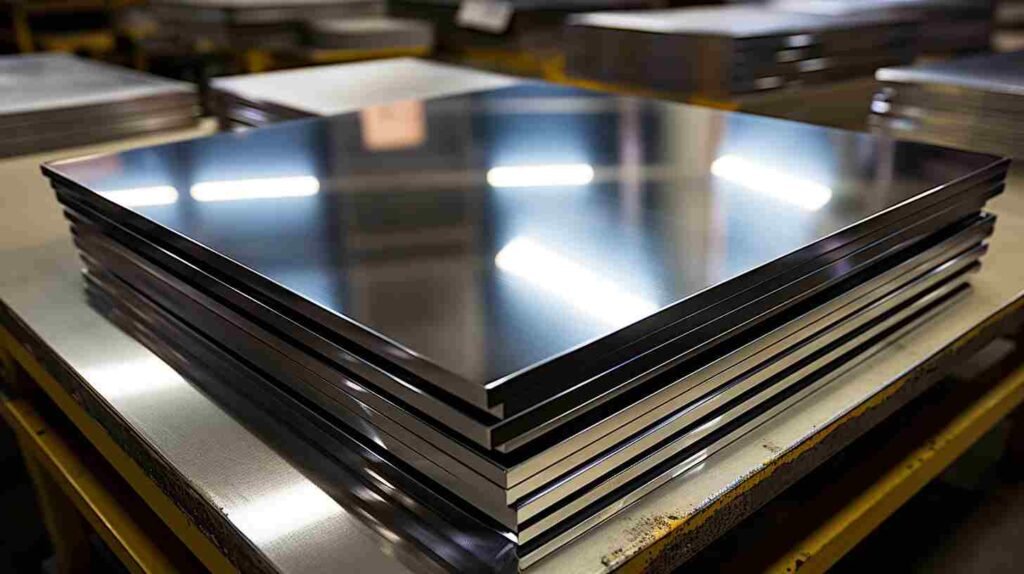About Stainless Steel Sheet Metal Fabrication
Embracing the exceptional qualities of the 300 series alloys, recognized as austenitic stainless steel, one finds an unrivaled material for sheet metal fabrication. The blend of superb formability, remarkable ductility, and unmatched weldability propels its desirability. Elevated levels of chromium and nickel in these alloys amplify their corrosion resistance, soaring above traditional steel standards. And when it comes to hygiene? Their easy-to-clean nature renders them indispensable for food processing scenarios.
In essence, stainless steel isn’t just any material; it’s the go-to choice for sheet metal components. Its resilience against corrosion, superior mechanical traits, and premier formability position it as the prime candidate for challenging environments. Whether it’s the unforgiving conditions of marine depths, the stratosphere’s heights in aerospace, or the stringent demands of the chemical processing realm – stainless steel stands unyielding.
Stainless Steel Sheet Metal at a Glance
| Application | Enclosures, structural components |
|---|---|
| Advantages | Excellent corrosion resistance, excellent formability |
| Disadvantages | Relatively high cost, mechanical properties inferior to normal steel & duplex stainless steel |
| Minimum Lead Time | 3 days |
| Standard Tolerances | 1.0 degree tolerances are possible on bent features and a cutout accuracy of +/- 0.020 in (0.508 mm) |
| Sheet Thickness | Maximum of 3/8 in (9.525mm) and a minimum of 0.0126 in (0.32 mm) |
Stainless Steel 301
Stainless Steel 301 emerges as a budget-friendly counterpart to its more expensive peers, like 304 stainless steel. This cost efficiency stems from its elevated carbon composition, balanced by reduced chromium and nickel elements. However, one must be cautious: while it’s more wallet-friendly, Stainless Steel 301 does not match up in corrosion resistance compared to other premium-grade stainless steels designed for sheet metal fabrication. Despite this, its adaptability is commendable, making it a popular choice for everything from the structural frameworks of rail transport to the robust casings of household appliances.
Stainless Steel 301 Properties
Tensile Strength, Yield (MPa)
205
Fatigue Strength (MPa)
240
Elongation at Break (%)
40
Hardness (Brinell)
217
Density (g/cm^3)
8
Stainless Steel 304
Stainless Steel 304, with its hallmark austenitic crystalline composition, stands as one of the most sought-after steel grades in the industry. While many often mistakenly equate it with 18-8 stainless steel, nuanced distinctions exist in its alloy constituents. Renowned for its robust defense against corrosion and unparalleled formability, it has become the material of choice for sheet metal parts. From the rigorous environments of food processing units featuring equipment like storage tanks to the critical support of structural bracketing, Stainless Steel 304 continues to be an industry favorite.
Stainless Steel 304 Properties
Tensile Strength, Yield (MPa)
215
Shear Modulus (GPa)
77
Elongation at Break (%)
70
Hardness (Brinell)
123
Density (g/cm^3)
8
Stainless Steel 316
Distinguished by its austenitic nature, Stainless Steel 316 integrates molybdenum, amplifying its fortitude against corrosion. This enhancement doesn’t stand alone. The alloy boasts an exceptional capacity for formability and welding, harmonizing its strength with flexibility. Venturing beyond its innate characteristics, its real-world applications speak volumes. Whether it’s the unyielding chemical tanks bearing the brunt of reactive substances or marine equipment dancing with the saline waves, Stainless Steel 316 emerges as the trusted choice for parts braving corrosive environments, making it a paragon in the realm of durable metals.
Stainless Steel 316 Properties
Tensile Strength, Yield (MPa)
290
Shear Modulus (GPa)
74
Elongation at Break (%)
50
Hardness (Brinell)
217
Density (g/cm^3)
8
Finishes
Natural Finish: This basic finish retains the stainless steel’s original texture post its shaping processes. Welded components undergo pickling and passivation, ensuring consistency across all surfaces. Often the top pick for traditional stainless steel applications.
Epoxy Shielding: Epoxy treatments grant a robust and durable finish. Although stainless steel inherently resists numerous chemicals, alloys like 304 may fall short compared to the 316 variant. Epoxy not only compensates for these gaps but also amplifies anti-corrosion capabilities.
Satin Polish: Achieved by gentle abrasion techniques, it bestows a sleek, satin-like matte appearance. Typically chosen for aesthetic enhancements, it adds a touch of elegance to the metal.
Crafting each piece to perfection, these finishes accentuate the steel’s inherent beauty and functionality.

Cost-saving Design Tips
Optimal Material Selection: Not all metals created for sheet metal fabrication are equally cost-effective and efficient. Prioritize understanding the specific requirements of your project. While some metals excel in certain conditions, they may falter in others. A comprehensive understanding of their reactions in diverse environments can be crucial. consult with a Fabrication Pro for insights.
Adherence to DFM: Embracing the DFM (design-for-manufacturing) ethos is pivotal when sketching out designs for sheet metal parts. Familiarize yourself with essential design principles to harness the full potential of fabrication methods without inflating costs.

Get A Free Quote
Contact us to get a free quote and more expertise about sheet metal fabrication. Your project will meet the right solution with Shengen.
Custom Sheet Metal Fabrication with Easy
At Shengen, We turn complex Into Simple! Follow the following three steps to start today!
- Tell us as specific as possible of your needs, provide the drawing, reference picture and share your idea.
- We will work on the best solution according to your requirements and drawing, the specific quote will be provided within 24 hours.
- We will start mass production after getting your approval and deposit, and we will handle the shipment.
